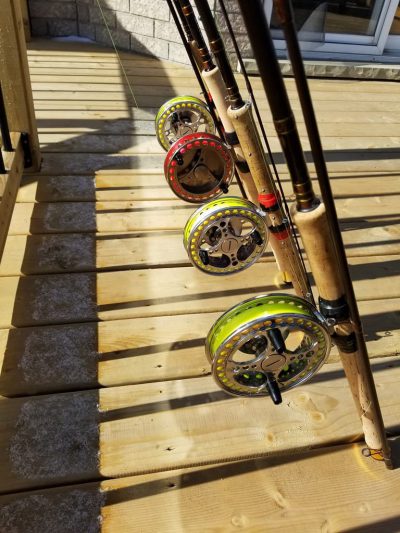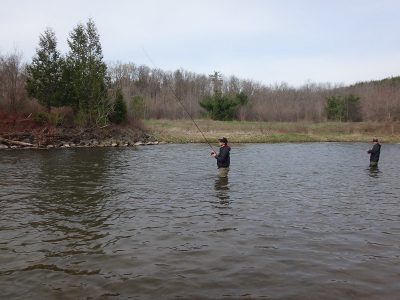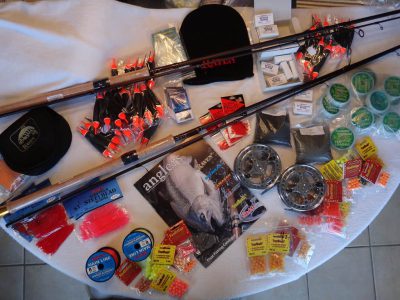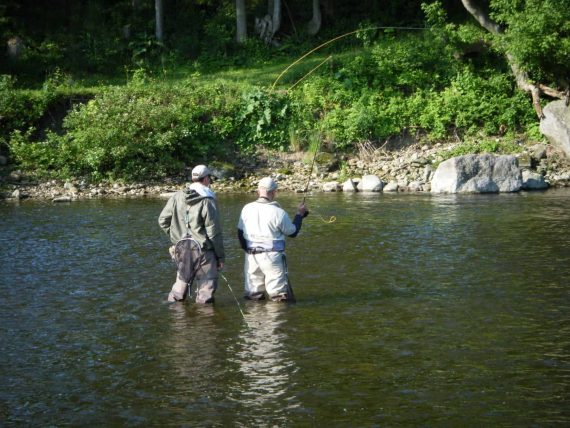Ontario Centerpin and Float Fishing – Have you ever wondered why some guys catch all the fish? We know why and we can show you the successful methods and tricks used by the best float fisherman.
The Most Effective Method: Centerpin float fishing is arguably the most effective method for catching great lakes steelhead, salmon and migratory brown trout and it has resulted in many days of over 20 steelhead landed for my customers. In my opinion in some river situations it just cant be beat y any other method. With our 30 years experience in this method my classes, individual lessons and guide trips can help you catch more steelhead then you ever thought possible. While other anglers struggle and use the “just cast and watch it go” method, I teach anglers the proper and most effecting methods. I can provide nearly everything you need for your trip out with us.

What is Centerpin fishing?
Centerpin fishing is also known as float fishing or to some it’s just called pinning. What ever you want to call it, it is basically called that because of the type of reel that is used to drift a bait of some sort under a float.
What is float fishing?
Float fishing is basically a term used to describe presenting a bait of some sort below a float or bobber while fishing in a river with current for trout, steelhead or salmon. Float fishing doesn’t actually require a Centerpin reel and some anglers are using spinning reels and bait cast reels instead but regardless of the reel the method and the goal is the same.
The Beginning of Centerpin Fishing: I’m not entirely sure when Centerpin fishing started but I’m almost positive Centerpin fishing for river steelhead started right here in Ontario back in the early 80’s.
When I first started Centerpin fishing almost 30 years ago I had to wait about 4 or 5 days of fishing on the river before I saw another Centerpin angler on the water, just so I could watch them cast so I could learn how to do it myself. That was a time when not only was Centerpin fishing almost unheard of but there was no internet or literature written anywhere to help a new angler like me learn.
Now as I write this in 2018 there are guides like me and there is tons of information like this on the internet to help new anglers learn how to do it and it seams like 7 out of 10 anglers on the rivers are using Centerpin rods and reels now.
The Start of Centerpin Guiding in Ontario: Even with all the good information available now it’s not uncommon to see anglers struggling with the method and just plain not catching very many fish. I tell my clients it’s not just a matter of casting out the float and watching it go, there’s so much more to it if you really want to catch lots of fish.
In 2006 we introduced Centerpin float fishing guided trips and lessons because of the many requests from our customers that were still struggling with different aspects of Centerpin fishing.
Back then I had almost 20 years experience with this very effective method so I decided it was something that would fit right in and I’m glad I did because on average I am netting over 300 steelhead for my customers each fall and many of these silver bullets are caught using a Centerpin.
I don’t know of or think there were any full time Centerpin guides in Ontario before we started guiding with Centerpin reels which makes us the first and still the only full time Centerpin guide in Ontario. Since 2006 we have become recognized as the premier Centerpin and float fishing guide company in Ontario offering multiple classes and guided trips to Centerpin anglers.

The Centerpin Reel: The Centerpin reel is designed so that there is a smooth round spool that is set on a base which has a thin pin type of post sticking up in the middle, and this is all the spool sits on. It basically sits on a center pin, hence where the name Centerpin comes from.
This pin / post has very high end bearings or bushings and this allows the spool to free spool with zero effort.
This free spooling action allows the angler to cast a float and the bait out and with just the pull of the current it will start spinning the reel and pulling the line off the reel as the float progresses down the river.
This action allows angler to run very long drifts with no mending of the line, or no feeding of the line by hand, the reel basically does that for you, and that provides greater line speed control and very smooth presentation.
These long smooth drifts allow the angler to suspend or hand the bait in the strike zone for extended periods of time or full for the full length of the pool or spot they are fishing.
I get asked all the time about what centerpin rods and reels I like the best. Check out this Centerpin Page Link for a full list of all the centerpin gear I use and recommend.
The Float Rod: The float fishing rods used in float fishing are usually long fairly whippy rods in the 11 to 15 foot range, with the average rod length around 13 feet. What size rod is best depends on a few factors but basically a longer rod would be used and larger wider rivers and a shorter rod would be used on smaller rivers or if a lot of bush whacking is required.
The extra long rods allow the angler to do a few things better then a shorter rod. The long rod allows the angler to make longer casts and then keep the line up and off the water for an extended time.

2 anglers fishing with 13 foot float rods
The longer rod also allows anglers to hang more line below the float for deep water fishing making which makes it easier to cast. As an example it would be very difficult to cast 8 feet of line hanging below the float with only a 7 foot rod but 8 feet could easily be cast with 13 foot rod.
The long rod acts like a giant shock absorber and helps anglers play the fish on very light lines which is often required for more hits from steelhead in clear water, it’s not uncommon to see anglers landing big fish on 4lb test leader because of these long rods.
Lastly, the long rod allows you to get better reach by extending the tip much further out into the middle of the river which gives you more control and straighter drifts at times. All of these things a advantages of a longer rod which means more fish in the net for anglers. One of the best rods with a great feel when setting the hook and playing great lakes steelhead is this The St.Croix Avid. I have guide friends that own centerpin rods that are 2 or 3 times more expensive and they still say this rod is there favorite. Check it our on Amazon HERE . . . or through our other recommended retailers HERE . . . .
Centerpin Versus Spinning Reel:
Now here is a debatable topic because float fishing can also be done with a spinning reel on a long float rod and many anglers still use spinning reels to float fish. Before Centerpin reels became so popular using spinning reels was the norm but if you watch anglers on the busy river today it’s more common to see more Centerpin reels being used then spinning reels and for good reason. Generally speaking if I see an angler using a spinning reel for float fishing they are either older and haven’t wanted to switch over to a Centerpin or they are new and less skilled anglers. I’m sure I’ll upset some spin fishing anglers with that statement but that’s been my observations from both guiding and from fishing the rivers for over 35 years.
Coming from a spinning reel background and being a guide that offers guided trips with spinning reels it is my opinion that a Centerpin reel is superior to a spinning reel when float fishing for many reasons with the key reason being a better controlled presentation.
I would never go back to a spinning reel myself because of this reason, not to mention how much fun a Centerpin reel can be.
One of the main advantages of a Centerpin reel is not only does the line come off the reel of a Centerpin smoother but it’s much easier to control the speed of the line as it comes off and that allows the angler to control the float and bait speed better for a much more controlled drift, which in my opinion is critical if you want to catch the most amount of fish possible.
I also believe the hook sets on a Centerpin reel are faster and easier to do since there is no line bail to flip over first before you set the hook.
I do find on occasion that spinning reels have a tighter loop or coil memory due to a smaller diameter line spool, which can also effect how the line comes out of the guides and can negatively effect your presentation.
The Best Gear and Baits Used for Float Fishing:
The gear we use is simply a long Centerpin rod and Centerpin reel, lined with specialty main lines, and a good sensitive float combined with light fluorocarbon leaders, micro swivels, split shots and good quality hooks, baited with a variety of offerings. But remember that even though you have all the right gear and the best baits, it’s all useless if you don’t know the key fundamentals of presenting all that to the fish. I’ve guided anglers that have caught 10 fish out of a pool when other anglers in the same pool, using all the exact same stuff are only catching one or 2 fish which is a common scenario and is primarily because of their poor presentation and lack of skills.
The Baits: Some of the more popular baits for Centerpin fishing is roe, also known as egg sacs or spawn. The plastic worms in pink, red and brown can also be deadly at times. Glass and plastic beads in sizes from 6mm to 12mm have also grown in popularity over the last 10 years and can be a very good choice for anglers. Flies and even jigs or jig flies are another popular bait and can be the best choice under the right conditions. There are a few other options for anglers like plastic, live or dead minnows, live worms, and I’ve even seen anglers catch steelhead on marshmallows or gummy bears cut into egg shapes. are also very popular for river anglers in the great lakes region. For more in depth info on Centerpin gear that I use and recommend go HERE . . . .

The Floats: There is a range of floats for anglers to use and these floats range from tall to skinny and can be solid balsam or plastic / foam or even clear hollow plastic ones. There is also slip float that guys use for very deep rivers like the Niagara river.
Knowing the right float to use and knowing how to set it up is important and something we teach anglers on our guide trips and lessons.
Since you are always using floats for this technique, this is where the name “Float Fishing” comes from.
Best Centerpin Main Line: The mainline is the line that is on the Centerpin reel and a good mainline is important for improved drifts and lesson problems. I recommend a good quality mainline that is thin, supple and floats. Using to heavy of a mainline will create sag between the rod tip and the float possibly causing unneeded drag. There are times when during extra long drifts or in very slow water it may be required to lay the line on the water and if the line sinks and gets pulled by the current it can create extra pull on the float and even make the hook sets difficult but a floating line will allow the angler to lift and mend the line easier to control drag, control slack and provide better hook sets. My line of choice is the Raven Tackle 8lb mainline. The color of the main line is personal preference since any color will do but I prefer the high-viz yellow which is easy for you and other anglers around you to see but if you don’t know how to set up the leader line properly this may not be the best line for you.
The Best Leader: The leader is important because it should be the lightest line in your set up but still needs to be invisible to the fish but strong enough to not break off a big fish and it must have good knot strength and be abrasion resistant. A good quality fluorocarbon line is best for this. The diameter and pound rating depends on a lot of factors such as average size of fish, size of river and how many obstructions like log jams there are and the clarity of water. As an all around suggestion I recommend a leader diameter of 0.20mm for steelhead and 0.26mm for salmon. Be careful buying your leaders by the companies pound test rating as they are often not accurate.
Swivels, Split Shots and Hooks: These things are often personal preference as what I might like and have confidence in someone else’s opinion may be very different. A basic guide line is to find out and use what is working best for other anglers on the river you want to fish. The local fishing and fly shops will often be able to help you with the best selection so pay them a visit.
Once you get all this gear together, its important to set it all up correctly and then even more important is the learn how to fish it right. There’s a lot more to it then just casting it out and watching it go if you want to really catch as many as possible or if you want to be that 1 guy out of 10 that catches 5 fish to everyone else’s 1 or 2.

Buy The Right Gear: I’m a big believer that the right gear and the right baits mean more fun on the river and more fish.
Fishheads Canada, On-Line: If you’re an angler around the great lakes region and you like to buy your products on-line you can get all your Centerpin gear at Fishheads Canada. These guy are hard core river anglers and know what works and what doesn’t so you’ll get the right gear and the right advice.
Drift Outfitters, Toronto: You can also drop in and visit the guys at Drift Outfitters in Toronto. These guys sell a bunch of Centerpin and float fishing gear and are there in the store for local anglers that want great face to face great advice with a great selection of float fishing and fly fishing products. This is the premier store and its centrally located in the middle of many of Ontario’s best steelhead rivers.
Local Tackle Shops: In my area I believe the best advice and the most suitable gear and tackle for the local rivers come from the smaller fly fishing and tackle stores. Help support these small business and you’ll have that great advice and great service available when you need it most.
Angling Sports, London: For those anglers down in the London Ontario area, the best place for fly fishing and float fishing products is Angling Sports. The all sell just about everything fishing related. Check them out on line – HERE
Best Time to Learn to Centerpin Fish
Best Times Prime Time Fall: October 1st to November 30th – The steelhead start showing up in the rivers around September 1st or just after the first big rains of September and it’s all dependent on the weather and river conditions. These fall steelhead have been out in the big waters feeding heavily and when they return at this time of year they’re at their strongest and therefore can be the best fighting fish of the year. Anglers do Centerpin fish for salmon as well at this time of year and they can start showing after some of the bigger rains in early august. By the middle of October the rivers are usually full of steelhead with many 10 to 20 fish days from Mid October to Mid November. Even though this time is the busiest time of year for me as a steelhead guide some good numbers of steelhead can be caught in early October and it’s not uncommon to have great days even as late as the end of December as long as the weather stays warm enough to not freeze up the river.
Prime Spring Time: April 1st to May 15th Although the river conditions are hit and miss this time of year we have some great days in the spring. The most success in from the 4th Saturday in April until the 2nd week in May.
Winter Fishing: December 1 to March 15 It’s usually pretty cold in January and February but the fishing can be hot if the conditions are good. We’ve had 30 fish days between January and March but we don’t usually pre-book trips during this period. If this is the type of trip you are interested in, contact us and get on our waiting list and we will call you when the fishing is hot.
Centerpin / Float Fishing Guided Lessons
This may be a first for any guide shop or any guide in Ontario but it’s not a first for us. We’ve been teaching beginner techniques and the finer points of Centerpin fishing to Ontario anglers for years.
This is a great way for beginners and intermediate anglers to learn how to float fish effectively and dramatically increase their catch rate.
Have you ever wondered why some anglers seem to catch a lot more fish then others? We know why, and we can show you how! We’ve been Centerpin fishing for almost 30 years, long before Centerpin fishing was even heard of by most river anglers in Ontario. Our experience with a float rod can help you become a better angler.
We Cover:
- The gear basics
- The casts
- The presentations methods that will produce way more fish
- The best set ups for maximum results
- Reading water tactics and fishing shallow or deep water
- Timing and understanding the runs for more fish
- Using the water level charts and my personal notes to help you decipher them better
- Depth finding and float placement
- Trotting, what is it and why will you catch way more fish when you perfect it
- Most productive baits for all our migratory species
- Shot patterns for different conditions
- Controlling and fighting big fish better and landing them faster
*** all gear can be provided or use your own rod and reel.
BONUS TIP OF THE DAY
Hold It Back: There is a technique in float fishing known as “trotting” and if done correctly it can greatly improve your catch. Unfortunately very few anglers do this well, or even at all.
Trotting is simply holding your float back a little to achieve a slight angle in the line that allows the bait to go ahead of the float. Unfortunately few anglers do this well and I’d bet if I asked 100 anglers on the river 95 out 100 anglers would not know the real reason why this works so well if done right. In fact i see guys doing it wrong all the time. Even experienced anglers reading this right now are thinking to themselves, “I know this, it’s so your bait goes first and you don’t spook the fish with the line, split shots and the float”. Well, if that’s what you think, you’re mostly wrong! You see, as a guide of 20 years and a Centerpin angler of 30 years I’ve had plenty of time on the water to analyze this. I teach this to my guide clients along with 2 other very important tactics.
As an example of why this matters let me tell you a true story. As a request from one of my regular customers one morning he asked me to fish with him which is something I never do. He was convinced he was doing it right despite two hours of my constant coaching and me telling him that if done right he should be catching 5 times as many steelhead. Finally he said he could learn better if he watched me do it and he wanted me to prove that more fish could be caught. So I did! I fished with using the exact same rod, reel, line, set-up and the same bait and I out-fished him 13 steelhead to his 1 in only 2 hours. Once I proved my point and I went back to guiding and coaching him now he worked much harder to get it right, now that he saw the difference between doing it perfect versus not doing it very well. The next day he sent me a text telling me he was out-fishing his buddy 6 to 1 and he buddy kept asking what he was doing different?
Trotting is one of 3 very important thing you must do on every single drift and if mastered, it will greatly improve your catch.

RIVER FISHING TIPS AND ADVICE
Have you ever wanted to know what the guides know? Now you can!
Anglers ask me all the time about what rods and reels and other gear that I recommend, or they ask me about my best flies, or my best methods or even which rivers are good to fish. I build a website that cover’s all of that and more . . . . . You should checkout our sister site where I tell you exactly what gear you need and i give you free tips and tricks to help you catch more fish. Check out www.ontariotroutandsteelhead.com
Jordan
Head Guide / Owner
MORE . . .
Get a whole lot more on updated information about Fly Fishing, Centerpin Fishing and Spin Fishing For Trout and Steelhead on my new Blog Website. Current Blog Topics Include:
